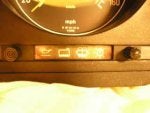September 2022. Updated to include information on replaced components. See post # 19 below.
It was annoying to me that the low coolant light was burned out, so I figured I'd replace it. Not that I need it, I check all the fluids regularly.
I took out the instrument cluster and found that on my 560SL, the four center warning lights are part of a "warning module," part number 1075420127. Evidently they expect you to replace the whole thing for $150, even if it's just got one 15 cent bulb burned out.
![]()
![]()
The back of the module is the brown circuit board below the speedo. Remove the two small screws and the module pulls right out.
Behind the plastic strip that has the icons, the bulbs are found down at the end of a series of shafts, and are soldered to a circuit board.
![]()
I found that you can take the module apart by pulling the rear most circuit board.
![]()
![]()
Then after removing a small screw, and lifting up and out, the board with the bulbs comes out.
Using a soldering iron and a soldering sucker, I removed the bulb from the PCB. Those bulbs are different from the other cluster bulbs, they are frosted and say "14 Volts" on the side. I decided to just replace the bulb with a regular cluster bulb, so I bent the terminals on a bulb so they stuck out and I soldered it into place. I could have used an LED, but I didn't feel like sorting out the polarity of the contacts.
More on the next post.
It was annoying to me that the low coolant light was burned out, so I figured I'd replace it. Not that I need it, I check all the fluids regularly.
I took out the instrument cluster and found that on my 560SL, the four center warning lights are part of a "warning module," part number 1075420127. Evidently they expect you to replace the whole thing for $150, even if it's just got one 15 cent bulb burned out.


The back of the module is the brown circuit board below the speedo. Remove the two small screws and the module pulls right out.
Behind the plastic strip that has the icons, the bulbs are found down at the end of a series of shafts, and are soldered to a circuit board.

I found that you can take the module apart by pulling the rear most circuit board.


Then after removing a small screw, and lifting up and out, the board with the bulbs comes out.
Using a soldering iron and a soldering sucker, I removed the bulb from the PCB. Those bulbs are different from the other cluster bulbs, they are frosted and say "14 Volts" on the side. I decided to just replace the bulb with a regular cluster bulb, so I bent the terminals on a bulb so they stuck out and I soldered it into place. I could have used an LED, but I didn't feel like sorting out the polarity of the contacts.
More on the next post.








